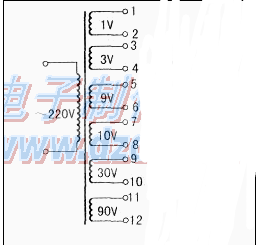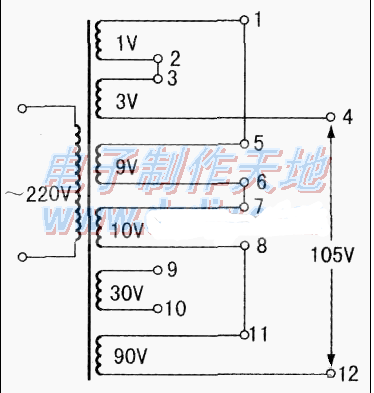For electronic enthusiasts, fresh things or experiments are their greatest interest. This article will introduce how to make a convenient multi-voltage transformer. You can make different transformer powers according to the materials around you. You can change them. The connection mode of each winding terminal of the output terminal can obtain any voltage of 1V.
Electronic enthusiasts often need a certain value of AC voltage when conducting electronic circuit experiments. There are two solutions to this problem: one is to use an auto-tuning transformer to adjust the required voltage, or to wind the required voltage transformer according to the requirements of the circuit. The former is bulky and expensive, and fans generally do not have such conditions, and the output is connected to the mains and is not safe enough during use. The latter is time-consuming and labor-intensive, and it is not easy to change the output voltage after winding.
Now introduce a multi-voltage transformer with a progressive voltage of 1V and a maximum output voltage of 143V to the majority of electronic enthusiasts. Although there are only 6 windings, as long as it is within 143V, by changing the connection mode of each winding terminal of the output terminal, any voltage with an accuracy of 1V can be obtained, which is extremely convenient to use in electronic experiments. The circuit is shown on the right.

In the figure, the primary winding of the transformer is AC 220V, and the secondary is divided into six independent windings. The voltages are 1V, 3V, 9V, 10V, 30V, 90V. In the experimental use, we only need to change the connection method of the output terminals of the transformer secondary to get the various voltages we need.
The various voltage values ​​output by this transformer are shown in the table above and the table below. The above table has a progressive voltage of 1V. The table below has a progressive voltage of 10V. The voltage values ​​listed in the two tables can be combined to achieve the various voltages required within 143V by properly connecting the outputs of some of the windings.
For example: we need an output voltage of 105V, as follows: First, combine 100V as shown in the following table:
Terminals 8 and 11 are connected, and the voltages output from terminals 7 and 12 are 100V. Then press the above table to combine 5V:
Terminal 2 is connected to 3, 1 is connected to 5, and the voltage output from terminals 4 and 6 is 5v. Terminals 6 and 7 are connected, and the output voltages of terminals 4 and 12 are 105V, as shown in the following figure.

Taking into account the actual situation of electronic enthusiasts in the test, 1V ~ 30V is often used in audio and other experiments, the current required is larger, and the wire diameter is coarser when winding the secondary winding. The voltage above 90V is generally used for experiments with lower voltage and current, and the wire diameter can be appropriately thinner. The power of the transformer is larger, about 150VA. The specific data is as follows: the core should be made of high-silicon steel sheet with a cross-sectional area of ​​17 square centimeters. After calculation, it is wound at 3 volts per volt. The primary 220V winding is wound with φ0.6 high-strength enamelled wire around 660 åŒ, and the secondary insulation is applied after the electrostatic isolation layer and interlayer insulation. 1V, 3V, 9V, 10V windings are wound with φ1.2 high-strength enameled wire, 3åŒ, 9åŒ, 27åŒ, 30åŒ, 30V winding with φ0.7 high-strength enameled wire wound 90åŒ, 90V winding with φ0. 5 high-strength enameled wire wrapped around 270 inches. In the winding process of each winding, we must pay attention to the winding direction, and must not be mistaken. The head and tail of each winding are distinguished by two different color plastic sleeves, and the numbers are marked in order.
Electronic enthusiasts can also increase or decrease the power of the transformer based on the specific conditions of their own materials. The specific data can be recalculated with reference to relevant data.
After the transformer is wound, it can be treated with dip paint. Make another case and drill some ventilation holes on both sides. The output terminals of the secondary 1V, 3V, 9V and 10V, 30V, and 90V winding groups are respectively mounted on both sides of the upper casing, and are marked with the serial numbers of 1 to 6, 7 to 12. After printing the above table and the table below according to the size of the case, it is attached to the outside of the case and covered with a 2mm thick plexiglass plate, so that the form is not easily scratched or worn. The 220V power cord and plug must be grounded with a three-core strip. Connect one line of the ground to the core of the transformer and the lead of the electrostatic isolation layer. The power switch and indicator light are installed at your discretion.

A spherical lens refers to a constant curvature from the center to the edge of the lens, while a non-spherical lens continuously changes the curvature from the center to the edge.
The aspheric lens has a radius of curvature that changes with the central axis to improve optical quality, reduce optical components, and reduce design costs. Aspheric lenses have unique advantages over spherical lenses, so they are widely used in optical instruments, imaging, and optoelectronics industries, such as digital cameras, CD players, and high-end microscopy instruments.
This lens has a better radius of curvature and can maintain good aberration correction to obtain the required performance. The application of aspheric lenses brings excellent sharpness and higher resolution.
Precision Polished Aspheric,Lenses Aspheric,Condenser Lenses,Parabolic Lens
Bohr Optics Co.,Ltd , https://www.bohr-optics.com
